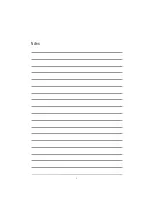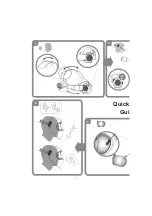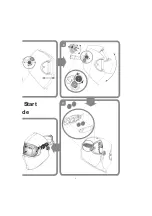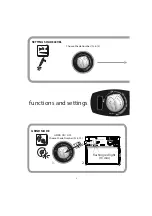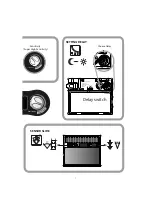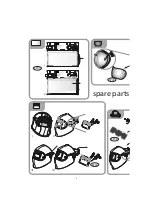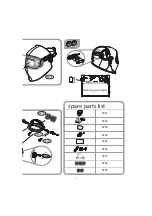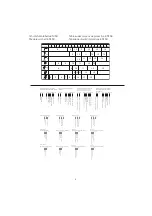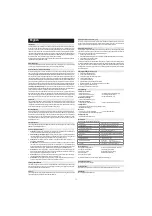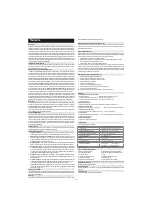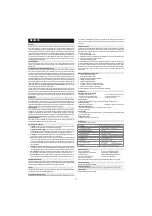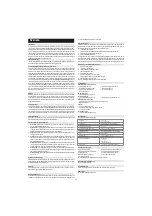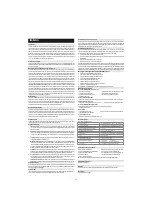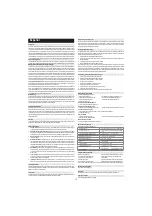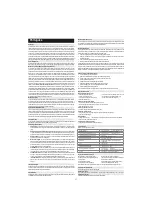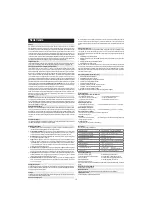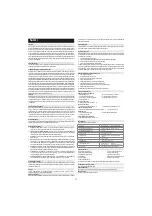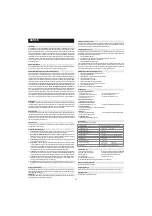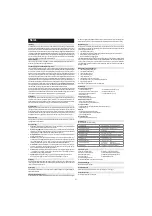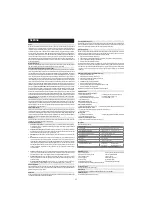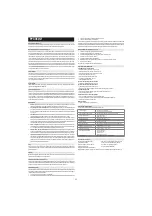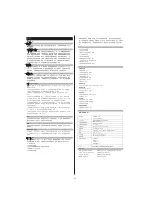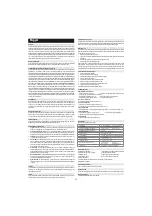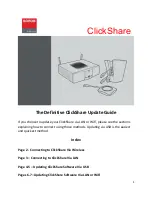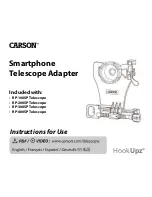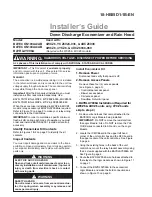
11
Introduction
A welding helmet is a type of headgear used when performing certain types of welding to protect the eyes,
face and neck from flash burn, ultraviolet light, sparks, infrared light, and heat. The helmet consists of
several parts (see spare parts list). An automatic welding filter combines a passive UV and a passive IR
filter with an active filter, the luminous transmittance of which varies in the visible region of the spectrum,
depending on the irradiance from the welding arc. The luminous transmittance of the automatic welding
filter has an initial high value (light state). After the welding arc strikes and within a defined switching time,
the luminous transmittance of the filter changes to a low value (dark state).
Depending on the model, the helmet can be combined with a protective helmet and / or with a PAPR
(Powered Air Purifying Respirator) system.
Safety instructions
Please read the operating instructions before using the helmet. Check that the front cover lens is fitted
correctly. If it is not possible to eliminate errors, you must stop using the cartridge.
Precautions & protective restrictions / Risks
During the welding process, heat and radiation are released, which can cause damage to the eyes and
skin. This product offers protection for the eyes and face. When wearing the helmet, your eyes are always
protected against ultraviolet and infrared radiation, regardless of the shade level. To protect the rest of your
body, appropriate protective clothing must also be worn. In some circumstances, particles and substances
released by the welding process can trigger allergic skin reactions in correspondingly predisposed
persons. Materials that come into contact with skin may cause allergic reactions to susceptible persons.
The protective welding helmet must only be used for welding and grinding and not for other applications.
The manufacturer assumes no liability when the welding helmet is used for purposes other than intended or
with disregard for the operating instructions. The helmet is suitable for all established welding procedures,
excluding gas and laser welding
.
Please note the recommended protection level in accordance with
EN169 on the cover.
Scratched or damaged lenses must be replaced. The helmet does not replace a safety
helmet. Depending on the model, the helmet can be combined with a protective helmet.
The helmet can affect the field of view due to constructive specifications (no view on the side without
turning the head) and may affect a color perception due to the light transmission of the auto darkening
filter. As a result, signal lights or warning indicators may not be seen. Further there is an impact hazard
due to a larger contour (head with helmet on). The helmet also reduces the audio and heat perception.
Sleep mode
The cartridge has an automatic switch-off function, which increases the service life. If the light falls on the
catridge for a period of approx 10 minutes less than 1 Lux, it automatically switches off. To reactivate the
cartridge,it must be briefly exposed to daylight. If the shade cartridge cannot be reactivated or does not
darken when the welding arc is ignited, the batteries must be replaced.
Warranty & liability
Please see the instructions of the national sales organisation of the manufacturer for warranty provisions.
For further information in this respect, please contact your official dealer. Warranty is only granted for
material and manufacturing defects. In the case of damage caused by improper use, unauthorised
intervention or through usage not intended by the manufacturer, the warranty or liability are no longer
valid. Likewise, liability and the warranty are no longer valid if spare parts other than those sold by the
manufacturer are used.
Expected Lifetime
The welding helmet has no expiration date. The product can be used as long as no visible or invisible
damage or functional problems occur.
How to use (Quick Start Guide)
1.
Head band.
Adjust the upper adjusting band (p. 2) to the size of your head. Push in the ratchet knob
(p. 2) and turn until the head band fits securely but without pressure.
2.
Distance from eyes and helmet angle.
By releasing the locking knobs (p. 2-3), the distance between
the cartridge and the eyes can be adjusted. Adjust both sides equally and do not tilt. Then tighten the
locking knobs again. The helmet angle can be adjusted using the rotary knob (p. 4).
3.
Shade Level.
The shade level can be changed by turing the knob from shade level SL 8- SL 12
according to standard EN 379,
4.
Grinding mode.
Press the Grind button (p. 4) to switch the cartridge to grinding mode. In this mode
the cartridge is deactivated and remains in light mode shade level SL 2.5. The activated grinding
mode is indicated by the red flashing LED (p. 4) inside the helmet. To deactivate grinding mode, press
the Grind button level knob again. After 10 minutes, the grinding mode is automatically reset.
5.
Sensitivity.
Use the sensitivity knob (p. 5) to set the ambient light sensitivity. The position "Super
High" is the standard sensivity setting. By turning the knob, these can be customized. In the "Super
High" area the maximum light sensitivity can be achieved.
6.
Sensor slider.
The sensor slider can be set to two different positions. Depending on the position,
the ambient light detection angle is reduced (p. 5) or increased (p. 5).
7.
Delay switch.
The opening knob (Delay) (p. 5) allows to select an opening delay from dark to light.
The knob allows infinite adjustment from dark to light between 0.05 to 1.0 s.
Cleaning and disinfection
The shade cartridge and the front cover lens must be cleaned with a soft cloth at regular intervals. No
strong cleaning agents, solvents, alcohol or cleaning agents containing scouring agent must be used.
Scratched or damaged lenses must be replaced.
Storage
The welding helmet must be stored at room temperature and at low humidity. Storing the helmet in the
original packaging will increase the service life of the batteries.
Replacing the the front cover lens (p. 6-7)
Push in one side clip to release the front cover lens and then remove it. Attach the new front cover lens to
one side clip. Pull the front cover lens round to the second side clip and clip in place. This action requires
some pressure to ensure that the gasket on the front cover lens has the desired effect.
Replacing the batteries (p. 3)
The cartridge has replaceable Lithium button cell batteries, type CR2032. If you are using a welding helmet
with a fresh air connection, you must remove the face seal before replacing the batteries. The batteries
must be replaced when the LED on the cartridge flashes in green.
1. Carefully remove the battery cover
2. Remove the batteries and dispose of them in accordance with the national regulations for special waste
3. Insert CR2032 type batteries, as shown
4. Carefully replace the battery cover
If the shade cartridge does not darken when the welding arc is ignited, please check battery polarity.
To check whether the batteries still have sufficient power, hold the shade cartridge against a bright
lamp. If the green LED flashes, the batteries are empty and must be replaced immediately. If the shade
cartridge does not operate correctly in spite of correct battery replacement, it must be declared unusable
and must be replaced.
Removing/installing the cartridge (p. 6)
1. Pull out the protection level knob
2. Carefully remove the battery cover
3. Unlock the cartridge retention spring as shown
4. Carefully tilt the cartridge out
5. Unlock the satellite as shown
6. Pull the satellite out through the gap in the helmet
7. Rotate the satellite by 90° and push through the hole in the helmet
8. Remove / replace the shade cartridge
The cartridge is installed in the reverse order.
Troubleshooting
Cartridge does not darken
ĺ$GMXVWVHQVLWLYLW\S
ĺ&KDQJHWKHVHQVRUVOLGHUSRVLWLRQS
ĺ&OHDQVHQVRUVRUIURQWFRYHUOHQV
ĺ'HDFWLYDWHJULQGLQJPRGHS
ĺ&KHFNWKHOLJKWIORZWRWKHVHQVRU
ĺ5HSODFHWKHEDWWHULHVS
Protection level too bright
ĺFKRRVHDORZHUVKDGHOHYHOS
Protection level too dark
ĺFKRRVHDKLJKHUVKDGHOHYHOS
ĺ&OHDQRUUHSODFHIURQWFRYHUOHQVS
Cartridge flickers
ĺ$GMXVWSRVLWLRQRIWKHGHOD\NQRESRQZHOGLQJSURFHGXU
ĺ5HSODFHWKHEDWWHULHVS
Poor vision
ĺ&OHDQWKHIURQWFRYHUOHQVRUFDUWULGJH
ĺ,QFUHDVHWKHDPELHQWOLJKW
ĺ$GMXVWWKHSURWHFWLRQOHYHOWRWKHZHOGLQJSURFHGXUH
Welding helmet slips
ĺ$GMXVWWLJKWHQWKHKHDGEDQGS
Specifications
(We reserve the right to make technical changes)
Shade Level
SL2.5 (light mode) SL8 – SL12 (dark mode)
UV/IR protection
Maximum protection in light and dark modes
Switching time from light to dark
ȝV&)ȝV&)
Switching time from dark to light
0.05 - 1.0s
Dimensions of cartridge
90 x 110 x 7mm / 3.55 x4.33 x 0.28“
Dimensions of field of vision
50 x 100mm / 1.97 x 3.94“
Power supply
Solar cells, 2 pcs. LI batteries 3V replaceable (CR2032)
Weight
500g / 17.637 oz
Operating temperature
-10°C – 70°C / 14°F – 157°F
Storage temperature
-20°C – 80°C / -4°F – 176°F
Classification as per EN379
Optical class = 1 Light scatter = 1
Homogeneity = 1 Angle of vision dependency = 2
Standards
CE, ANSI Z87.1, compliance with CSA Z94.3
Spare parts (p. 6-7)
-Helmet without cartridge (SP01)
-Repair set 1 (Potentiometer knob, Sensitivity
-Cartridge incl. satellite (SP02)
knob, Battery cover) (SP06)
-Front cover lens (SP03)
-Head band with fastener (SP07)
-Repair set 2 (SP04)
-Sweat band (SP08 / SP09)
-Inner protection lens (SP05)
For detailed article number see inside cover of this manual (2nd last page).
Declaration of conformity
See internet link adress at last page.
Legal information
This document complies with the requirements of EU regulation 2016/425 point 1.4 of Annex II.
Notified body
See last page for detailed information.
English
Содержание Powershield 2.5
Страница 1: ...Manual ...
Страница 2: ...2 Notes ...
Страница 4: ...4 Quick Gui 1 2 6 5 ...
Страница 5: ...5 CR 2032 Li Mn 3V CR 2032 Li Mn 3V CR 2032 Li Mn 3V CR 2032 Li Mn 3V Start de 4 3 ...
Страница 38: ...38 Notes ...
Страница 39: ...39 ...


